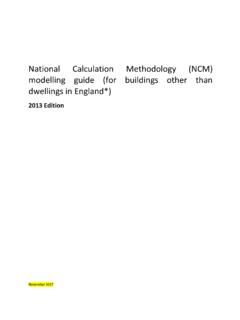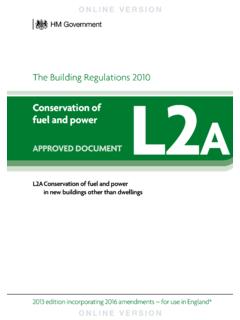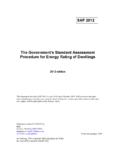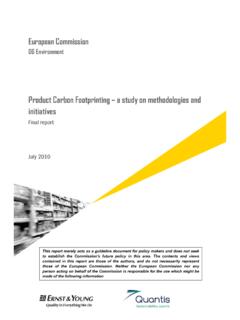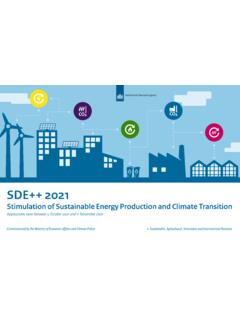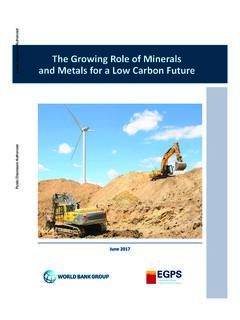Transcription of This report has been prepared for the Department of Energy ...
1 Industrial Decarbonisation & Energy Efficiency Roadmapsto 2050 MARCH 2015 This report has been prepared for theDepartment of Energy and Climate Change andthe Department for Business, Innovation and SkillsIron and SteelINDUSTRIAL DECARBONISATION AND Energy EFFICIENCY ROADMAPS TO 2050 IRON AND STEELP athways to Decarbonisation in 2050 Page iCONTENTSLIST OF FIGURES .. VLIST OF TABLES .. VIIACRONYMS .. SUMMARY .. is the Decarbonisation and Energy Efficiency Roadmap for the Iron and SteelSector?
2 The Iron and Steel Sector and Barriers for Decarbonisation in the Iron and Steel of Decarbonisation Potential in the Iron and Steel and Key Technology , INCLUDING METHODOLOGY .. Aims and Research of the is a Roadmap? and Next and Steel and Steel and Secondary Production of Iron and Stages in Iron and Steel for Delivering Heat and Power33 INDUSTRIAL DECARBONISATION AND Energy EFFICIENCY ROADMAPS TO 2050 IRON AND STEELP athways to Decarbonisation in 2050 Page Emissions and Energy Use Principal Question of Energy Consumption and CO2 and Power and Fuels of Equipment and Key Environment Principal Question and to Reduce carbon carbon of.
3 And Scenarios Introduction and Evolution Principal Question Potential and Pathway Analysis Principal Question 4 and as Usual CO2 Reduction CO2 Reduction Technical carbon and no carbon Capture80 INDUSTRIAL DECARBONISATION AND Energy EFFICIENCY ROADMAPS TO 2050 IRON AND STEELP athways to Decarbonisation in 2050 Page and carbon of Pathway Analysis of Enablers and Recovery with Advanced and rebuild solutions without PRINCIPAL QUESTION 6 .. , leadership and Case Energy costs, Energy supply security, market structure and Energy policy chain , Development and and Technology grid of and feedstock availability (including biomass) Efficiency and Heat Capture94 INDUSTRIAL DECARBONISATION AND Energy EFFICIENCY ROADMAPS TO 2050 IRON AND STEELP athways to Decarbonisation in 2050 Page.
4 106 INDUSTRIAL DECARBONISATION AND Energy EFFICIENCY ROADMAPS TO 2050 IRON AND STEELP athways to Decarbonisation in 2050 Page vLIST OF FIGURESF igure 1: Overview of the different decarbonisation and Energy efficiency pathways ..13 Figure 2: Roadmap methodology ..20 Figure 3: Evidence gathering process ..22 Figure 4: Crude steel production (in million tonnes) in the UK during 1993-2013 (UK Steel, 2014) ..31 Figure 5: Iron and steel secondary process routes ..32 Figure 6: Evolution of specific Energy consumption (in GJ/tonne steel produced) for the UK iron and steelsector since 1973 (EEF, 2014).
5 35 Figure 7: Direct and indirect emissions from the BF-BOF production of steel ( carbon Trust, 2011) ..36 Figure 8: 2012 distribution of Energy source use in the UK iron and steel industry (EEF, 2014)..37 Figure 9: Crude steel demand in the UK and domestic share (UK Steel, 2012) ..40 Figure 10: Schematic of iron and steel production processes (IIP, 2014) ..52 Figure 11: Performance of pathways for the current trends scenario ..56 Figure 12: Summary of analysis methodology ..58 Figure 13: Reference trends for the different 14: Option deployment for the BAU pathway.
6 62 Figure 15: Contribution of principal options to the absolute emissions savings throughout study period, forthe BAU pathway, current trends scenario ..63 Figure 16: Breakdown of 2050 emissions savings, for the BAU pathway, current trends scenario ..64 Figure 17: BAU pathways for the different scenarios ..65 Figure 18: Option deployment for the 20-40% CO2 reduction pathway ..66 Figure 19: Contribution of principal options to the absolute emissions savings throughout the study period forthe 20-40% CO2 reduction pathway, current trends scenario.
7 67 Figure 20: Breakdown of 2050 emissions savings, for the 20-40% CO2 reduction pathway, current trendsscenario ..68 Figure 21: Option deployment for the 40-60% CO2 reduction pathway ..69 Figure 22: Contribution of principal options to the absolute emissions savings throughout study period, forthe 40-60% CO2 reduction pathway, current trends scenario ..70 Figure 23: Breakdown of 2050 emissions savings, for the 40-60% CO2 reduction pathway, current trendsscenario.
8 71 Figure 24: Option deployment for the Max Tech pathway ..72 INDUSTRIAL DECARBONISATION AND Energy EFFICIENCY ROADMAPS TO 2050 IRON AND STEELP athways to Decarbonisation in 2050 Page viFigure 25: Contribution of principal options to the absolute savings throughout the study period, for the MaxTech pathway, current trends scenario ..73 Figure 26: Breakdown of 2050 emissions savings, for the Max Tech pathway, current trends scenario ..74 Figure 27: Max Tech pathway for the different scenarios ..75 Figure 28: Sensitivity analysis BF-BOF/EAF split, current trends scenario.
9 76 Figure 29: EU production (in thousand tonnes) of crude steel by steelmaking technology (OHF = open hearthfurnace) 2002-2011 (Egenhofer et al., 2013) ..77 Figure 30: Production of crude steel (in thousand tonnes) by steelmaking technology in selected EU memberstates in 2011 ..77 Figure 31: Sensitivity analysis BF-BOF/EAF split, current trends scenario ..77 Figure 32: Steel life cycle (Worldsteel, 2014) ..78 Figure 33: CO2 reduction potential using bio-PCI (Feliciano-Bruzual, 2014) ..80 INDUSTRIAL DECARBONISATION AND Energy EFFICIENCY ROADMAPS TO 2050 IRON AND STEELP athways to Decarbonisation in 2050 Page vii LIST OF TABLEST able 1: Energy -intensive industry total direct and indirect carbon emissions in 2012 (data sources includeCCA data, EU ETS and NAEI).
10 12 Table 2: Industrial sectors evaluated in this project ..17 Table 3: Inputs and outputs for the industrial decarbonisation and Energy efficiency roadmap to 2050 ..19 Table 4: Monthly crude steel production during 2013 (thousand tonnes) across geographic regions (adaptedfrom data in WorldSteel, 2013) ..31 Table 5: Direct and indirect emissions (2011-2013) from UK steel production (EEF, 2014) ..36 Table 6: Top Enablers ..45 Table 7: Top Barriers ..48 Table 8: Pathways and scenarios matrix ..59 Table 9: Summary costs and impacts of decarbonisation for the pathways.










